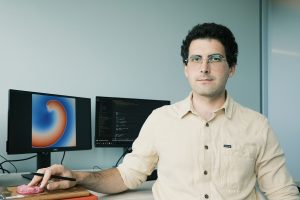July 30, 2025 — You may have heard the phrase “my heart skipped a beat” when someone was talking about a romantic encounter. In truth, hearts that beat irregularly are dangerous for your health. Atrial fibrillation (AF) is the most common type of irregular heartbeat, and over time, it can worsen and become a permanent condition, a severe disorder that’s the leading preventable cause of ischemic stroke, according to the NIH.
Nicolae Moise, a research scientist in the Department of Biomedical Engineering at Ohio State University (OSU), is using NCSA and OSC high-performance computing resources to explore the long-term progression of AF, in the hopes that his research can help with treatments that can stop AF before it becomes a lifelong condition. His work was recently published in JACC: Clinical Electrophysiology.
AF is a type of irregular heartbeat in which the upper chambers of the heart – the atria – beat out of synch with the lower chambers. What starts as an occasional occurrence over time becomes permanent. Human studies are difficult to conduct with the level of detail needed to perform the types of tests Moise is simulating.
“We are using cardiac electrophysiology models to investigate how short-term cardiac activity (ms – s timescale) causes long-term changes in cardiac tissue (days – weeks – months),” said Moise. “Our simulations are, to my knowledge, the longest ones to date, simulating up to 24 hours of continuous 2D electrical activity.”
Simulations allow researchers to control every aspect of the heart over a long period of time. How a heart works may seem relatively simple on the surface, but there are a lot of calculations involved in running a simulation at this level of detail of a human heart. That’s where the Center’s resources come into play. Moise used the U.S. National Science Foundation’s ACCESS program to get an allocation on NCSA’s Delta supercomputer to perform the complex heart simulations.
“All 2D simulations were performed using CUDA code, on NCSA and Ohio Supercomputer Center GPUs – this was critical in order to investigate such long timescales,” said Moise. “The NCSA resources we used were specifically NVIDIA GPUs available through Delta. By performing the simulations using CUDA code run on NVIDIA GPUs we were able to speed up our simulations by a factor of ~250. Since our longest simulations in this study take about one week to run, they would have taken on the order of years to be performed on a regular personal computer or laptop.”

Moise’s team uncovered some interesting heart behaviors when afflicted with AF. When a person has a rapid heartbeat, the heart cells adapt to keep calcium levels balanced. This incredible feature of heart cells comes with a significant drawback. The very same adaptations make the heart susceptible to continued arrhythmias or abnormal heartbeats. This creates a vicious cycle where more heart cells adapt to keep calcium levels balanced as the condition continues, which in turn makes the heart more susceptible to arrhythmias, eventually leading to a permanent irregular heartbeat.
Moise’s work shows exactly why catching AF early and treating it is crucial for heart health. “Our research investigates the most common cardiac arrhythmia, atrial fibrillation, which is a significant cause of cerebral stroke, and thus morbidity and mortality, through computer simulations of the heart’s electrical activity,” said Moise. “This work allows us, for the first time, to track the initiation and long-term progression of this disease, which will ultimately lead to better drugs that prevent or halt its progression.”
Moise’s research has the potential to greatly improve treatment for AH, giving doctors and researchers a new perspective on the mechanisms that lead to its progression. Research like this can also inspire work in similar fields, assisting researchers studying other areas of cardiac health and beyond.
“We believe that our work opens up a new time dimension in cardiac electrophysiology simulations, showing that day-long simulations (or even more) are technically feasible,” said Moise. “This approach can be applied to a variety of diseases, such as sinoatrial node dysfunctions or arrhythmias caused by myocardial infarction. In addition, this work directly advances research in atrial fibrillation, allowing for the first time to model its long-term progression caused by arrhythmic electrical activity, as well as opening up the potential for testing treatments that directly address intracellular regulation. Finally, more broadly, our work can hopefully inspire other researchers to tackle biological problems that span large timescales.”
In future studies, Moise intends to take the simulation his team developed and introduce possible treatments. The team will also continue to work toward validating their findings through additional experiments. Previous related work was published in Biophysical Journal.
Source: Megan Meave Johnson, NCSA






 Buzz Aldrin’s footprint in the lunar regolith, a fine powdery material that may make a fine material for building future constructions on the Moon (Credit : NASA)
Buzz Aldrin’s footprint in the lunar regolith, a fine powdery material that may make a fine material for building future constructions on the Moon (Credit : NASA)



